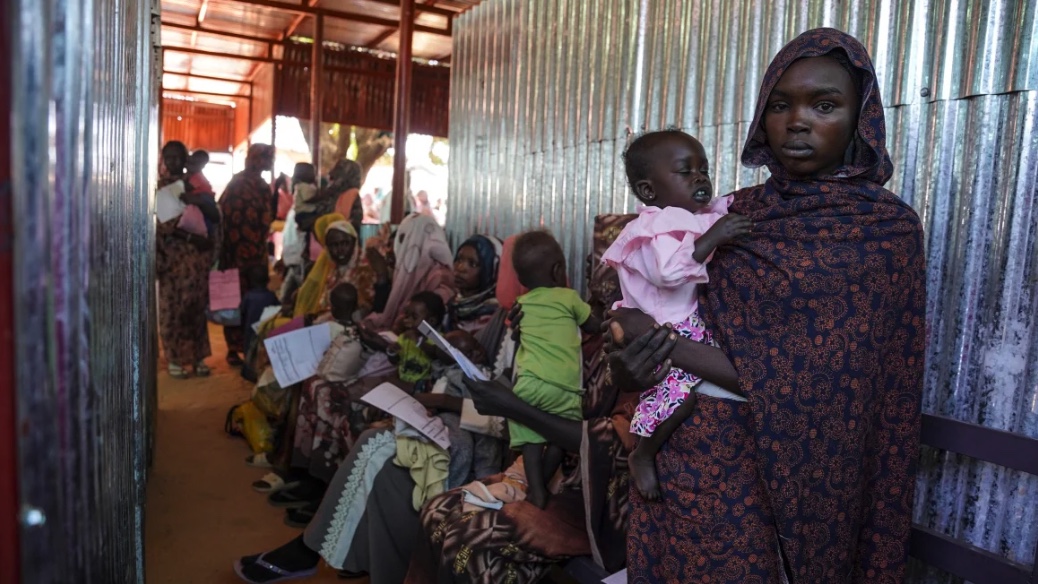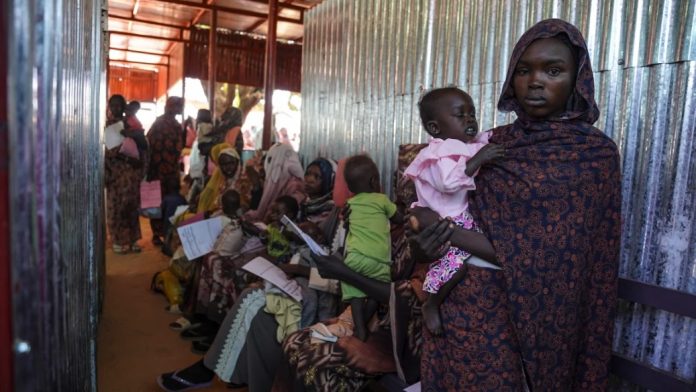ความอดอยากได้รับการประกาศอย่างเป็นทางการในค่ายผู้ลี้ภัยในภูมิภาคดาร์ฟูร์ของซูดาน ซึ่งปัจจุบันให้ที่พักพิงแก่ผู้คนหลายแสนคน การประกาศนี้เกิดขึ้นหลังจากสงครามกลางเมืองยาวนานถึง 15 เดือน ค่ายซัมซัม (Zamzam camp) ใกล้กับเอลฟาเชอร์ต้องเผชิญกับภาวะอดอยากตั้งแต่เดือนมิถุนายน ตามการระบุของคณะกรรมการพิจารณาความอดอยาก Famine Review Committee (FRC) ที่ได้รับการสนับสนุนจากสหประชาชาติ ประชากรในค่ายเพิ่มขึ้นเป็นประมาณครึ่งล้านเนื่องจากความขัดแย้ง การประกาศภาวะอดอยากอย่างเป็นทางการเกิดขึ้นไม่บ่อยนัก โดยนี่เป็นเพียงครั้งที่สามนับตั้งแต่ระบบติดตามเฝ้าระวังก่อตั้งขึ้นเมื่อ 20 ปีที่แล้ว และเป็นครั้งแรกในรอบกว่า 7 ปี การประกาศดังกล่าวมักมุ่งหวังที่จะได้รับความช่วยเหลือจากนานาชาติมากขึ้นเพื่อป้องกันการเสียชีวิตเพิ่มเติม
รายงานดังกล่าวแม้จะมุ่งเน้นไปที่ค่ายซัมซัม แต่ก็เตือนว่าพื้นที่อื่นๆ ในซูดานก็มีความเสี่ยงที่จะเกิดความอดอยากเช่นกัน เนื่องจากความขัดแย้งที่ดำเนินอยู่และการเข้าถึงด้านมนุษยธรรมที่จำกัด เอล ฟาเชอร์ เมืองหลวงของดาร์ฟูร์เหนือ ถูกกองกำลังสนับสนุนอย่างรวดเร็ว Rapid Support Forces (RSF) ปิดล้อมตั้งแต่เดือนเมษายน พ.ศ. 2566 โดยความขัดแย้งได้แพร่กระจายและสร้างความเสียหายให้กับคาร์ทูม สหประชาชาติเรียกสถานการณ์นี้ว่า “หนึ่งในภัยพิบัติด้านมนุษยธรรมที่เลวร้ายที่สุดในความทรงจำล่าสุด” โดยมีผู้พลัดถิ่นภายในประเทศมากกว่า 10 ล้านคน และมากกว่า 25 ล้านคนเผชิญกับความหิวโหยเฉียบพลัน รายงานเมื่อวันพฤหัสบดีถือเป็นการประกาศภาวะอดอยากอย่างเป็นทางการครั้งแรก แม้ว่าโครงการอาหารโลก World Food Programme (WFP) ได้รายงานไปแล้วเมื่อเดือนพฤษภาคมว่า ชาวเมืองดาร์ฟูร์กินหญ้าและเปลือกถั่วลิสงเนื่องจากความหิวโหยอย่างรุนแรง
การจำแนกระยะความมั่นคงทางอาหารแบบบูรณาการ Integrated Food Security Phase Classification (IPC) ให้คำจำกัดความความอดอยากว่าคือการขาดแคลนอาหารอย่างรุนแรง ซึ่งนำไปสู่ความอดอยาก การเสียชีวิต และภาวะทุพโภชนาการขั้นรุนแรง จะประกาศภาวะอดอยากหากผู้ใหญ่สองคนหรือเด็กสี่คนต่อประชากร 10,000 คนเสียชีวิตทุกวันจากความอดอยากหรือสาเหตุที่เกี่ยวข้อง FRC ประกาศภาวะอดอยากครั้งล่าสุดในปี 2560 ในซูดานใต้ และก่อนหน้านี้ในโซมาเลียในปี 2554 ในซูดาน FRC ถือว่าภาวะอดอยากดังกล่าวมีสาเหตุหลักมาจากความขัดแย้งและการขาดการเข้าถึงด้านมนุษยธรรม ไม่ใช่สภาพอากาศ FEWS NET ที่ได้รับการสนับสนุนจากยูเอ็นยังได้ประกาศภาวะอดอยากในค่ายซานซัม โดยเตือนว่าอาจแพร่กระจายไปยังเอล ฟาเชอร์ ซึ่งเป็นที่อยู่ของประชาชนเพิ่มอีก 800,000 คน ทั้งสองกลุ่มคาดหวังว่าภาวะอดอยากจะคงอยู่อย่างน้อยจนถึงเดือนตุลาคม และเรียกร้องให้ฝ่ายต่างๆ ที่ทำสงครามประกันว่าจะมีการส่งความช่วยเหลือเพื่อบรรเทาผลกระทบ
Famine has been declared in Sudan’s Darfur region following months of civil war.

Famine has been officially declared in a refugee camp in Sudan’s Darfur region, which now shelters hundreds of thousands of people. This declaration comes after 15 months of civil war. The Zamzam camp near El Fasher has faced famine conditions since June, according to the UN-backed Famine Review Committee (FRC). The camp’s population has grown to around half a million due to the conflict. Official famine declarations are rare, with this being only the third since the monitoring system was established 20 years ago and the first in over seven years. Such declarations often aim to secure more international aid to prevent further deaths.
The report, while currently focused on the Zamzam camp, warns that other areas in Sudan are also at risk of famine due to ongoing conflict and limited humanitarian access. El Fasher, North Darfur’s capital, has been under siege by the Rapid Support Forces (RSF) since April 2023, with the conflict spreading and devastating Khartoum. The UN has called the situation “one of the worst humanitarian disasters in recent memory,” with over 10 million internally displaced and more than 25 million facing acute hunger. Thursday’s report is the first official famine declaration, though the World Food Programme (WFP) had already reported in May that Darfur residents were eating grass and peanut shells due to extreme hunger.
The Integrated Food Security Phase Classification (IPC) defines famine as extreme food deprivation leading to starvation, death, and severe malnutrition. A famine is declared if two adults or four children per 10,000 die daily from starvation or related causes. The FRC last declared a famine in 2017 in South Sudan and previously in Somalia in 2011. In Sudan, the FRC attributed the famine primarily to conflict and lack of humanitarian access, not weather. The UN-backed FEWS NET also declared famine at the Zanzam camp, warning it might spread to El Fasher, home to an additional 800,000 people. Both groups expect the famine to persist at least until October and urged warring parties to ensure the delivery of aid to mitigate its impact.
By CNN NEWS

















